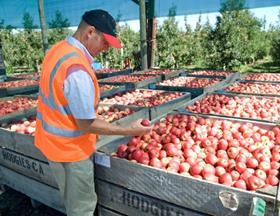
Pipfruit New Zealand has issued its 2012 export crop estimate that puts this year’s deal in line with the previous.
Pipfruit New Zealand chief executive Peter Beaven said this year’s crop was unusual in that it is consistent with 2011 volumes. “In the previous five years we have seen significant production swings from year to year because apple trees tend to be naturally biennial bearing and also because of frosts during flowering,” he said.
Royal Gala remained the main export variety and estimates were 5.7m cartons would be shipped during the season.
Volumes of the industry’s previous mainstay Braeburn, however, are expected to shrink 24 per cent this year to just 3.3m cartons – the lowest production in 20 years.
“The predicted low crop for Braeburn is a response from growers who have struggled for years to obtain sustainable returns from Europe,” Beaven said. “Tree removals and growing for processing instead of export have resulted in the Braeburn crop, a signature NZ variety, shrinking from a high of 8m cartons exported only six years ago.”
Harvesting is expected to take place slightly later than last year, said Beaven. “The late winter cold spell delayed flowering by up to two weeks with the result that the main Royal Gala harvest will not commence until late February.”
Growing conditions since New Year, however, have been ideal with warm days and enough cool mornings to get good colour development. Precipitation has been sufficient to keep soil moisture levels up and optimise fruit size, said Beaven.
Exporters from the country have received good interest from buyers in Asia where demand has been growing in recent year, he adds, while interest has also been good in older markets in the EU and North America. “New Zealand’s reputation as a reliable supplier of high quality, highly coloured, safe apples and pears enables us to command premium prices in all markets,” stated Beaven.
While Royal Gala and Braeburn still account for the majority of exports there has been a significant shift in the sector toward newer varieties.
Jazz is expected to top 2m cartons for the first time and will constitute 12 per cent of volume. Other large contributors will be Fuji with 1.7m cartons, the Pacific series with 1.1m and Pink Lady with 830,000 cartons.
New Zealand supplies apples to more than 60 countries with the EU, Asia and the Middle East taking the lion’s share.
Australia has recently emerged as a market for New Zealand after it won access to the country following the lifting of a 90-year-long ban. This season it is expected 10 packhouses will be cleared to send fruit across the Tasman provided stringent audits are passed.
The largest percentage of this year’s export volume will come from Hawke’s Bay, which will supply 61 per cent of the crop, or 10.1m cartons, while Nelson should export 5.3m cartons, or 32 per cent of the national crop. Of the smaller growing regions, Central Otago is the largest providing an estimated 656,000 cartons, while most of the balance of the crop will come from Waikato, Gisborne and Wairarapa.



